Hearing comments like this reminds me of the continued misunderstanding associated with why quality analyses differ between labs.
How can laboratory results differ when they are sent the “same” sample? To deal with this problem, the terms accuracy and precision must be addressed. Accuracy is a measure of the ability of the procedure to measure or predict the “true” value of a quality measure.
In forage analysis, accuracy implies how closely the quality measurements of the submitted sample compares to the true quality of the lot of forage it represents.
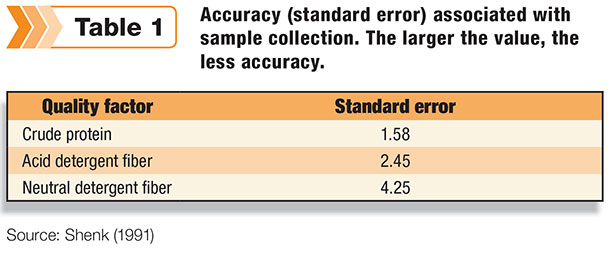
Accuracy of forage analysis is limited by the weakest link in the analytical procedure. For both wet chemistry and NIRS analysis, the limiting factor to accuracy is sample collection (Table 1).
The highest level of accuracy we can expect from a single sample from either chemical or NIRS analysis is plus or minus 1.58, 2.45 and 4.25 percentage units for crude protein (CP), acid detergent fiber (ADF) and neutral detergent fiber (NDF), respectively.
The result you receive back from a laboratory for CP could be 1.58 percentage units lower or higher than the lot of hay it represents. This degree of accuracy is due to the inability to obtain a sample that truly represents the lot of hay the sample is collected from.
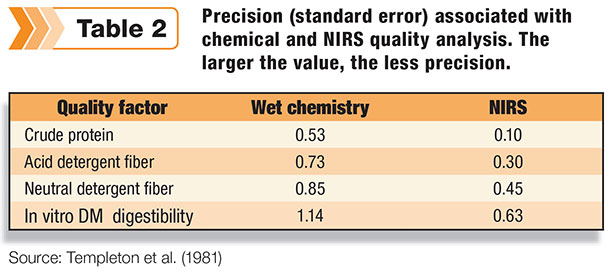
Precision, on the other hand, is the ability of a laboratory to repeatedly produce the same results. The precision of laboratories are much higher (lower standard errors) than the accuracy of the sample (Table 2).
The standard error values in Table 2 are much lower than in Table 1. This means that laboratory precision is much better than accuracy.
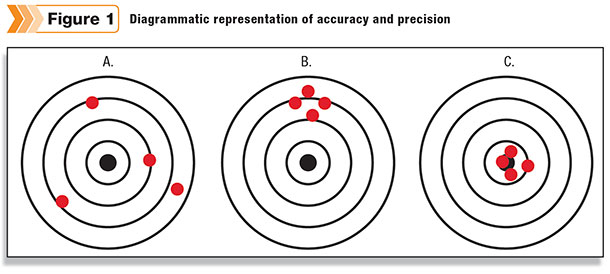
Another way to think about accuracy and precision is by using a target (Figure 1) to represent forage quality results. The center of the target represents the actual forage quality of the lot of hay in question.
The red dots are results received back from a single lab. Target A shows results that are neither accurate nor precise because they aren’t near the bull’s eye (accurate) and they aren’t clustered together (precise).
Target B shows results that are not accurate (miss the bull’s eye) but are precise because the values are all clustered in the same area of the target. Target C shows results that are both accurate and precise because they all cluster near the bull’s eye.
Realizing that laboratories need to have some method for improving and insuring their accuracy, a joint effort was undertaken by the American Forage and Grassland Council, National Hay Association and forage testing laboratories to improve accuracy.
Since its formation, reproducibility of lab results among laboratories has dramatically improved. Various lab methods have been reviewed and improved. More than 150 laboratories annually participate in the certification process. A list of participating labs is available online (National Forage Testing Association).
So why do labs reports differ when sent the “same” sample? More likely than not because the samples were not the same.
Since accuracy of sample collection is so much lower (higher standard error) than precision (Tables 1 and 2), sample collection is the limiting factor in the ability of a laboratory to produce identical quality results for samples collected from the same load of hay.
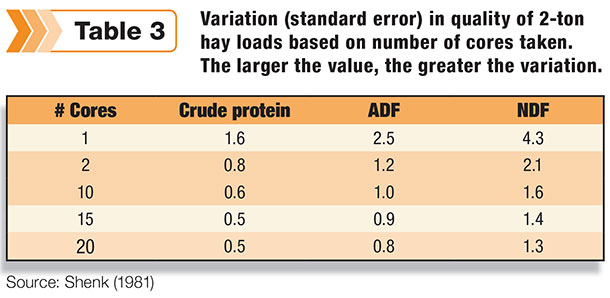
How many cores should be collected from a lot of hay to minimize the error associated with sample collection? The answer to this question is dependent on the size of the lot, but in general, five cores for every ton with a minimum of 10 cores per lot should be sufficient (Table 3).
Note that just taking the second core sample almost doubles the accuracy. Also, correctly sampling the bale is important so that the most representative sample as possible is collected.
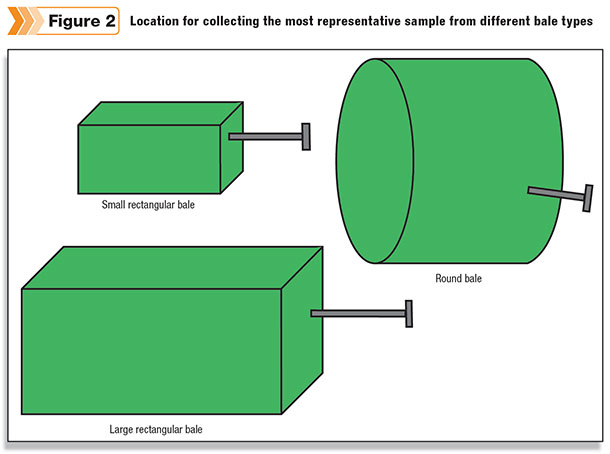
Figure 2 illustrates where the samples should be collected from different bale types.
In summary, the main reason for quality results differing between labs is that the labs did not receive identical samples. Sample collection is the major source of variability in forage quality analysis.
Improving the precision of laboratory analysis is mainly academic to farmers because errors in sample collection will mask any improvement in precision. FG

- Marvin Hall
- Professor Dept. of Plant Science
- Penn State University











